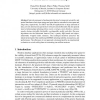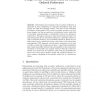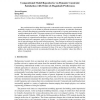493 search results - page 21 / 99 » Representing preferences using intervals |
SSD
2001
Springer
14 years 2 days ago
2001
Springer
Intervals represent a fundamental data type for temporal, scientific, and spatial databases where time stamps and point data are extended to time spans and range data, respectively...
HEURISTICS
2006
13 years 7 months ago
2006
Representing and reasoning with an agent's preferences is important in many applications of constraints formalisms. Such preferences are often only partially ordered. One clas...
EUSFLAT
2009
13 years 5 months ago
2009
One of the new trends in genetic fuzzy systems (GFS) is the use of evolutionary multiobjective optimization (EMO) algorithms. This is because EMO algorithms can easily handle two c...
JUCS
2007
13 years 7 months ago
2007
: Indexing video content is one of the most important problems in video databases. In this paper we present linear time and space algorithms for handling video metadata that repres...
CORR
2011
Springer
12 years 11 months ago
2011
Springer
The predominant knowledge-based approach to automated model construction, compositional modelling, employs a set of models of particular functional components. Its inference mecha...



